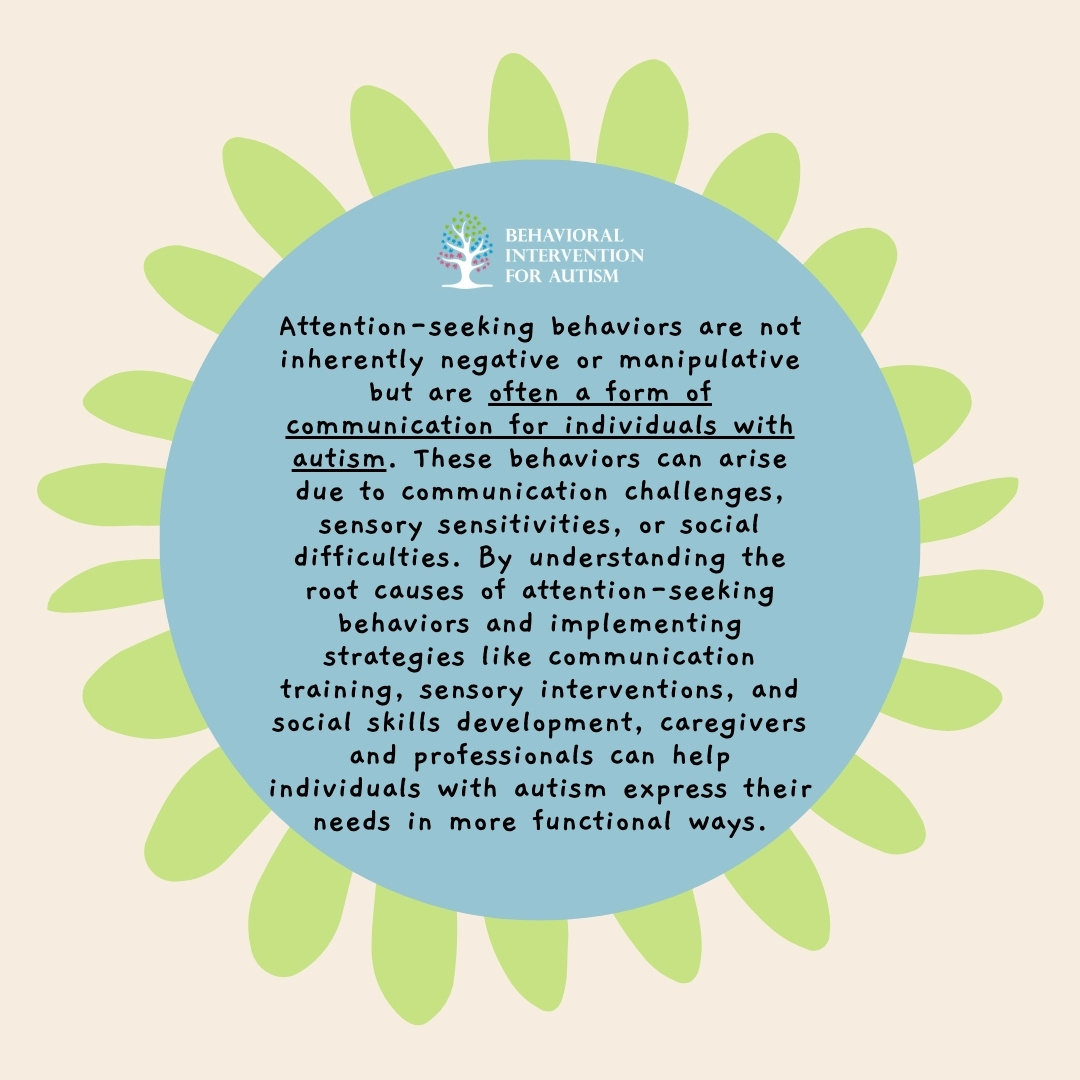
Table of Contents
Autism spectrum disorder (ASD) is a complex neurodevelopmental condition that affects how individuals interact with the world, process information, and behave. One common behavior that is often associated with autism is attention-seeking. However, whether this behavior is a typical part of the autism spectrum has been the subject of ongoing discussions. In this article, we will explore attention-seeking behaviors in individuals with autism, discuss why they may occur, and examine strategies, including ABA therapy, to support those who exhibit them.
Attention-seeking is a broad term used to describe behaviors where individuals try to attract the attention of others, whether through words, actions, or gestures. While it is a normal part of childhood development for all children, it can manifest differently in children with autism. Understanding this behavior in the context of autism is essential for parents, caregivers, educators, and therapists to provide appropriate interventions and support.
Is Attention-Seeking Behaviors Part of Autism?
Yes, attention-seeking behaviors can be a part of autism. Individuals with autism may engage in these behaviors as a way to communicate their needs, express frustration, or seek sensory stimulation. However, the nature and intensity of attention-seeking behaviors can vary greatly from person to person. It’s important to recognize that these actions are not necessarily intended for manipulation, but rather as a means of coping or connecting with their environment. Understanding and responding appropriately to these behaviors can help provide better support for individuals with autism.
Understanding Attention-Seeking Behavior
Attention-seeking behavior can manifest in various ways, from vocalizations and physical movements to more subtle gestures or facial expressions. While all children engage in attention-seeking behavior, the frequency, intensity, and method of expression may vary. For individuals with autism, this behavior might appear more pronounced or different than what we might expect in neurotypical children. It is important to distinguish between attention-seeking as a learned behavior versus a behavior arising from communication difficulties.
Communication Challenges in Autism
One reason attention-seeking behaviors are prevalent in individuals with autism is their difficulty in communication. Autism often involves challenges with both verbal and non-verbal communication. Many individuals with autism struggle to convey their needs, emotions, and thoughts in ways that others can easily understand. As a result, they may resort to attention-seeking behaviors as a way to get their needs met. These behaviors can include crying, repeating certain actions, or seeking physical closeness from others.
In some cases, attention-seeking might not necessarily be an intentional effort to disrupt or demand focus but could simply be the result of an individual’s frustration due to the inability to express themselves clearly. It’s important to recognize that these behaviors are not a reflection of manipulative intentions but are often a form of communication, especially in non-verbal or minimally verbal individuals.
The Role of Sensory Sensitivities
Another aspect that might explain attention-seeking in individuals with autism is sensory sensitivities. Many individuals with autism experience heightened or reduced sensitivity to sensory stimuli. For example, a person might seek attention when they are overwhelmed by an intense sensory experience, such as loud noises, bright lights, or certain textures. Sensory overload can be distressing, and the individual might use attention-seeking behaviors to draw attention to their discomfort in hopes of receiving help or alleviation.
In contrast, some individuals with autism might engage in attention-seeking behaviors to seek sensory stimulation. This could involve repetitive movements, such as hand-flapping or rocking, which might serve as a self-soothing mechanism or a way to fulfill sensory needs. These behaviors, while appearing to be attention-seeking, can actually be responses to sensory input, highlighting the complexity of autism-related behaviors.
Autism Spectrum Disorder and Social Interactions
Social challenges are another core characteristic of autism. Individuals with autism may find it difficult to understand social cues, read body language, or grasp the nuances of social interactions. This social disconnect can contribute to attention-seeking behaviors. For instance, a child may act out or speak loudly to gain the attention of others because they are unsure how to engage in typical conversational exchanges.
In addition, individuals with autism may struggle with social anxiety, especially in unfamiliar settings or with new people. Their attention-seeking behaviors can sometimes be a response to this anxiety, as they may feel uncomfortable being ignored or overlooked in social situations. In such cases, attention-seeking is not a manipulation tactic but rather a way to cope with the stress or confusion that arises in social contexts.
Attention-Seeking as a Strategy for Coping
It’s important to consider that, for some individuals with autism, attention-seeking behaviors can be a coping mechanism. For those who face challenges in processing emotions or sensory overload, engaging in attention-seeking behaviors might provide a sense of control or comfort. This is especially true for individuals with lower verbal skills, who may find it more difficult to express emotions through language.
If an individual’s attention-seeking behavior results in receiving positive reinforcement (such as a caregiver’s attention or a preferred activity), the behavior may become reinforced and repeated. This form of reinforcement can cause a cycle where the individual continues to engage in attention-seeking behaviors as a way to achieve comfort or control.
How Attention-Seeking Behaviors Differ Among Individuals with Autism
It is also important to note that not all individuals with autism will display attention-seeking behaviors in the same way. The spectrum of autism is vast, and behaviors vary significantly depending on an individual’s abilities, experiences, and environment. Some individuals may rarely seek attention, as they might prefer solitude or have difficulty connecting with others. Others may demonstrate more overt behaviors, such as interrupting conversations, shouting, or engaging in repetitive actions to maintain focus on themselves.
Additionally, an individual’s age, developmental stage, and the presence of other co-occurring conditions (such as ADHD, anxiety, or intellectual disabilities) can influence the nature and frequency of attention-seeking behaviors. It’s crucial to consider each person’s unique context when evaluating their behavior.
3 Strategies for Addressing Attention-Seeking Behavior in Autism
Understanding that attention-seeking behaviors are often rooted in communication or sensory challenges can guide parents, caregivers, and educators in developing effective strategies to address them. Below are some approaches that may help reduce the frequency of attention-seeking behaviors while fostering positive interactions.
Positive Reinforcement and Communication Training
Teaching individuals with autism appropriate communication skills is essential in addressing attention-seeking behavior. This may involve using speech therapy, augmentative and alternative communication (AAC) systems, or sign language to help the individual express their needs in a more functional way. By reinforcing positive communication efforts, caregivers and educators can help individuals replace attention-seeking behaviors with more socially appropriate ways of requesting help, attention, or resources.
Positive reinforcement, such as praise or preferred activities, should be used when individuals communicate effectively, helping them understand that there are alternative ways to get attention other than through disruptive behaviors. The goal is to build a connection between appropriate communication and positive outcomes, reducing reliance on attention-seeking actions.
Sensory Interventions
If sensory sensitivities are contributing to attention-seeking behavior, sensory interventions may be helpful. These might include creating a sensory-friendly environment with less stimulation or providing sensory tools such as weighted blankets, noise-canceling headphones, or fidget toys. By addressing the sensory needs of individuals with autism, it may be possible to reduce discomfort and, consequently, the need for attention-seeking behaviors.
For those who seek sensory input, providing structured opportunities for sensory activities (e.g., swinging, deep pressure, or textured toys) can help fulfill these needs in a way that doesn’t disrupt social interactions or daily routines.
Social Skills Training
For individuals whose attention-seeking behaviors stem from social challenges, social skills training can be beneficial. This type of therapy focuses on teaching individuals with autism how to understand social cues, recognize emotions in others, and engage in appropriate social interactions. By increasing their social awareness and confidence, individuals with autism may be less likely to engage in attention-seeking behaviors as a result of anxiety or misunderstanding in social situations.

It is essential to approach attention-seeking behavior with empathy and a focus on teaching alternative methods for communication and self-regulation. By doing so, we can foster a more inclusive and supportive environment for individuals with autism, empowering them to navigate the world in a way that reflects their unique strengths and needs.
Get the Support You Need for Your Child’s Behavior
If you’re noticing attention-seeking behavior in your child with autism, you’re not alone. Understanding these behaviors can be a challenge, but with the right support, it’s possible to manage them effectively. ABA therapy in Florida is an excellent option for children who need guidance in this area. We encourage you to reach out to us for personalized, compassionate care that focuses on improving behavior and fostering meaningful skills. Behavioral Intervention For Autism provides high-quality ABA therapy services that help children thrive. Contact us today and discover how we can support your child’s journey toward success!
- 9 Common Obsessions of Children With Autism You Should Know - February 25, 2025
- What is Neurodiversity? A Guide to Embracing Differences - February 25, 2025
- Understanding Hyperfocus in Autism: What It Means and Why It Happens - February 25, 2025


